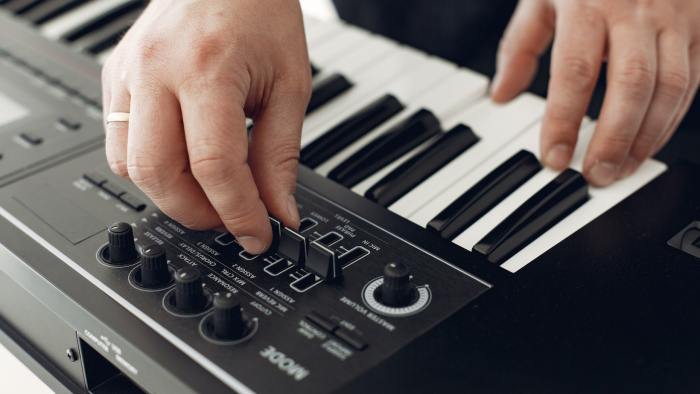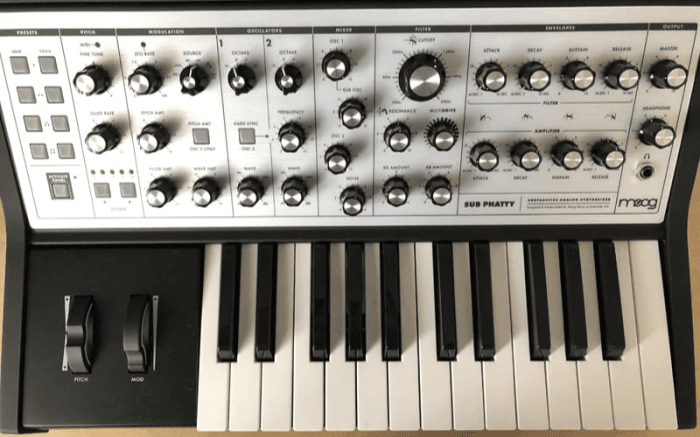In the realm of electronic music, the synthesizer stands out as an instrument of unparalleled versatility, capable of producing an astonishing array of sounds and styles. Yet, despite its ubiquity, the synthesizer has virtually no standard repertoire. This article delves into the reasons behind this lack of standardization, exploring the historical evolution of synthesizer sounds, its cross-genre applications, and the transformative power of customization and collaboration within the synthesizer community.
Defining the Lack of a Standard Repertoire

The synthesizer, an electronic musical instrument capable of producing a vast array of sounds, stands apart from traditional instruments in its absence of a standardized repertoire. Unlike instruments such as the piano or guitar, which possess a well-defined body of compositions and performance practices, the synthesizer’s sonic capabilities are boundless and constantly evolving.
This lack of standardization stems from several factors. Firstly, the synthesizer is a relatively young instrument, with its origins in the mid-20th century. In contrast, instruments like the violin or flute have centuries of musical tradition behind them, during which a vast repertoire has been accumulated.
Moreover, the synthesizer’s versatility and customizable nature contribute to its lack of a standard repertoire. With a wide range of parameters to manipulate, including pitch, timbre, envelope, and effects, each synthesizer can produce a unique and personal sound. This encourages experimentation and innovation among musicians, resulting in a diverse array of compositions that defy categorization.
Historical Evolution of Synthesizer Sounds

Early Analog Synthesizers
The earliest synthesizers, developed in the 1950s and 1960s, were analog devices that employed voltage-controlled oscillators, filters, and amplifiers to generate sound. These early synthesizers, such as the Moog Modular and Buchla Modular, were highly experimental and often difficult to control, but they laid the foundation for the development of more accessible and versatile synthesizers in the decades to come.
Digital Synthesizers
The advent of digital technology in the 1970s revolutionized the synthesizer landscape. Digital synthesizers, such as the Yamaha DX7 and Roland Juno-106, offered greater stability, precision, and a wider range of sounds than their analog predecessors. Digital synthesis also enabled the creation of new and innovative soundscapes, such as the ethereal pads and metallic textures that became synonymous with 1980s pop music.
Software Synthesizers, The synthesizer has virtually no standard repertoire
The development of software synthesizers in the 1990s further expanded the sonic possibilities of synthesizers. Software synthesizers, such as Native Instruments Massive and Ableton Operator, run on computers and offer an even wider range of sounds and features than hardware synthesizers.
They also facilitate easy integration with other digital audio tools, such as sequencers and effects processors.
Cross-Genre Applications and Adaptations
Electronic Dance Music
Synthesizers have played a central role in the development of electronic dance music (EDM) genres such as techno, house, and trance. EDM producers use synthesizers to create rhythmic patterns, basslines, and melodies that drive the dance floor. Synthesizers have also been used to create the distinctive soundscapes and atmospheric textures that characterize many EDM tracks.
Classical Music
Synthesizers have also found their way into classical music compositions. Composers such as Karlheinz Stockhausen and Wendy Carlos have used synthesizers to create electronic music that explores new sonic territories. Synthesizers have also been used in film and television scores, providing a futuristic or otherworldly atmosphere.
Experimental Music
Synthesizers are a staple of experimental music, where they are used to create sounds that defy traditional musical conventions. Experimental musicians use synthesizers to explore the boundaries of sound and create immersive and challenging listening experiences.
Customization and Personalization

Modular Synthesizers
Modular synthesizers are synthesizers that are built from individual modules, each of which performs a specific function, such as generating sound, filtering, or modulating. Modular synthesizers offer a high degree of customization, allowing musicians to create their own unique sound by patching together different modules.
Modular synthesizers are popular among electronic music producers and experimental musicians who seek to push the boundaries of sound design.
Software and Hardware Modifications
Software and hardware modifications can also be used to customize synthesizers. Software modifications, such as custom patches and presets, can alter the sound and functionality of a synthesizer. Hardware modifications, such as adding new modules or replacing components, can expand the sonic capabilities of a synthesizer and make it more versatile.
Collaboration and Community: The Synthesizer Has Virtually No Standard Repertoire

Open-Source Projects
The synthesizer community is a vibrant and collaborative one, with many open-source projects and online forums dedicated to sharing knowledge and developing new techniques. Open-source projects, such as the Mutable Instruments Plaits and the VCV Rack, provide musicians with access to affordable and powerful synthesizers that they can modify and customize to their own liking.
Online Forums and Communities
Online forums and communities, such as the Synthtopia forum and the Reddit synthesizer subreddit, provide a platform for synthesizer enthusiasts to connect with each other, share ideas, and learn from each other. These communities play a vital role in fostering innovation and promoting the growth of the synthesizer ecosystem.
Questions and Answers
Why does the synthesizer have virtually no standard repertoire?
The synthesizer’s lack of a standard repertoire stems from its inherent flexibility and the absence of a single, universally accepted approach to sound creation. Unlike traditional instruments with established playing techniques and tonal systems, the synthesizer offers a vast array of parameters and controls that allow musicians to craft unique and highly personalized sounds.
How has the synthesizer evolved over time?
The synthesizer has undergone a remarkable evolution since its inception in the mid-20th century. Early analog synthesizers, with their limited capabilities and unpredictable behavior, gave way to more stable and versatile digital synthesizers in the 1980s. Today, software synthesizers and modular systems offer unprecedented power and flexibility, enabling musicians to create sounds that were once unimaginable.
How is the synthesizer used in different musical genres?
The synthesizer has found a home in a wide range of musical genres, from electronic dance music and hip-hop to classical compositions and experimental soundscapes. Its ability to produce a vast array of sounds makes it a versatile tool for musicians seeking to explore new sonic territories and push the boundaries of musical expression.